Balancing the Enterprise Mix
 About the author: John Hansen is a Nebraska Landowner bringing his ideas and perspective to the forefront of our mission; to partner with landowners who value adaptive management and are seeking alternative sources of revenue. With an education in Animal and Range Sciences from Montana State University, several years managing small to medium sized ranches, and 26 years with Ted Turner managing some of the largest land holdings in the U.S., John brings a depth of knowledge and experience to LandTrust and its landowner partners. His strong background in agriculture and natural resource management provides a unique opportunity to share what he has learned through this extensive experience base with landowners to help them achieve a more profitable Land Business.
About the author: John Hansen is a Nebraska Landowner bringing his ideas and perspective to the forefront of our mission; to partner with landowners who value adaptive management and are seeking alternative sources of revenue. With an education in Animal and Range Sciences from Montana State University, several years managing small to medium sized ranches, and 26 years with Ted Turner managing some of the largest land holdings in the U.S., John brings a depth of knowledge and experience to LandTrust and its landowner partners. His strong background in agriculture and natural resource management provides a unique opportunity to share what he has learned through this extensive experience base with landowners to help them achieve a more profitable Land Business.
In this blog, we will continue the process of determining what enterprises will fit your operation and contribute to your bottom line. The one, of three, goals we discussed in the previous blog (Diversity in your Land Business) is the Production/Financial Goal. This is a goal most landowners are focused on, and for good reason. Without a solid financial footing in the business, the other goals can be much more difficult to attain. All of the three goals are important for the ultimate success of the business, but the Production/Financial Goal is the most straightforward to place numerical values on and measure. Additionally, it tends to drive what is possible to achieve various aspects of the Landscape Goal and the Quality-of-Life Goal.
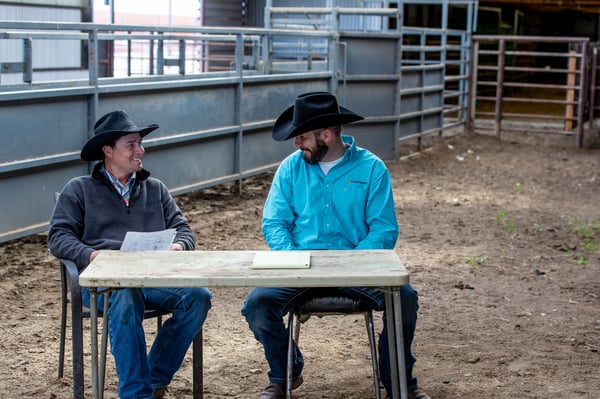 Landowner, Ches Meyer, discusses his goals with LandTrust customer success member, Mike Ryan.
Landowner, Ches Meyer, discusses his goals with LandTrust customer success member, Mike Ryan.
.jpg?width=428&name=_T4R5739%20(1).jpg)
There are several financial analysis tools and methods available to help the landowner make sound decisions concerning the financial aspects of their business. There is no one tool that can do all things. It generally takes several tools to successfully complete a project, whether it is building a house, a fence, overhauling the engine in your tractor, or developing your Land Business. Developing the correct set of tools (and knowing how to use them) for the job is imperative.
It is beyond the scope of this blog to get too in-depth in discussing the economic and financial analysis tools that are needed to perform a full analysis of your Land Business and its various (actual or contemplated) enterprises. Attending one of the classes listed at the end of my last blog is an excellent means to learn how to use them and their importance to the long-term success of your business. However, I will introduce one of my favorite analysis tools, Gross Margin, and give a simple example to illustrate how it can be utilized in the decision-making process.
Gross Margin – this is a means of measuring the production efficiency of an enterprise and how much it can contribute toward covering Overhead Costs. The formula is quite simple and is as follows:
Gross Product minus Direct Costs = Gross Margin
A few definitions to aid in our discussions:
Gross Product – The revenue received for your product. This should be enterprise specific.
Direct Costs – Expenses that vary with the production unit amounts or sizes. These expenses are tied to specific enterprises within the business. Often referred to as Variable Costs. Examples – feed costs, vet/med costs, special or temporary labor (specific to an enterprise), etc.
Overhead costs – Expenses that are relatively constant regardless of what or how much is being produced. Often referred to as Fixed Costs, although they can vary over time and circumstances. These costs are typically tied to the Land Business. Examples – land taxes, accountant fees, your salary, most land-based repair and maintenance, etc.
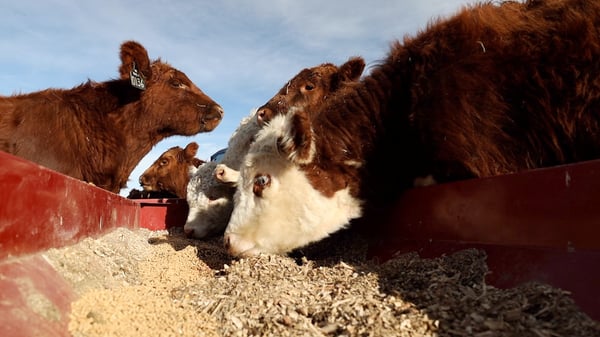
I like Gross Margin as it tends to give a good initial “feel” for whether an enterprise may be worth pursuing. This is a handy tool and can be expressed in various $/units (per acre, per animal unit, per dollar invested, etc.). One of my favorites when comparing various enterprises that do not have an obvious common unit of measure is the “per dollar invested”. This will allow you to compare, let’s say, your Cattle Enterprise to your Agritourism Enterprise (no obvious comparable units of measure other than dollars). It gives you a comparison that is “apples to apples”.
An example: (not necessary based on a real situation)
Cattle Enterprise Agritourism Enterprise
Gross Product $100,000 Gross Product $7,500
Direct Costs $ 60,000 Direct Costs $2,500
_____________________ ___________________
Gross Margin $ 40,000 Gross Margin $5,000
GM/$ invested $ 0.67 GM/$ invested $ 2.00
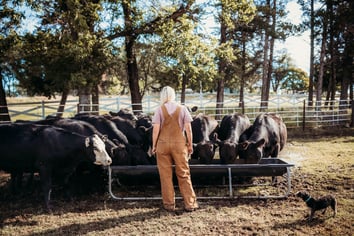
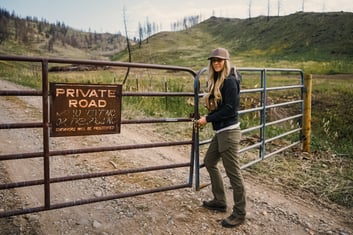
Landowner, Katie, feeding her cattle at KCK Farms. Recreator, Melissa, accessing land at MT Cow Company.
Looking at this example, it would appear that you should put all your effort into the Agritourism Enterprise due to the good marginal reaction per dollar spent – and maybe you should - to a point. However, you can’t ignore the $40,000 that the Cattle Enterprise is contributing to help cover Overhead Costs, it is a very important enterprise. This is why it is so important to remember that this analysis is only one of many measures that you should be utilizing when making decisions on the enterprise mix for your business. Other factors such as cash flow, total operational/business profit, etc. must be considered and weighed against your financial needs and your three overarching goals. Advice from your accountant and financial advisor or banker should be sought to avoid unintended consequences and provide another point of view (all part of the “team effort” for success).
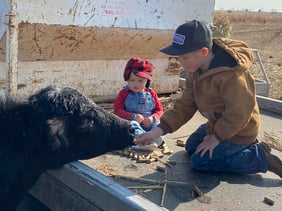 The example was only comparing two enterprises. I have heard of some landowners that account for 20+ enterprises on their land. This brings us to the consideration of – Are you a “lumper” or a “splitter”? I like to see operators that are sort of in between. In the example above, the Cattle Enterprise could have a cow/calf component and a yearling component. Both, most likely, have differing Gross Margins. It would be useful to know which has the best Marginal Reaction so management adjustments may be made to improve the component that is lowest. Also, the Agritourism Enterprise may have several activities or components that each bear scrutiny for best Marginal Reaction. The upshot is – if you “split” too much, you can lose focus looking at details and miss the big picture. If you “lump” too much you will lose valuable insight to what the data could tell you.
The example was only comparing two enterprises. I have heard of some landowners that account for 20+ enterprises on their land. This brings us to the consideration of – Are you a “lumper” or a “splitter”? I like to see operators that are sort of in between. In the example above, the Cattle Enterprise could have a cow/calf component and a yearling component. Both, most likely, have differing Gross Margins. It would be useful to know which has the best Marginal Reaction so management adjustments may be made to improve the component that is lowest. Also, the Agritourism Enterprise may have several activities or components that each bear scrutiny for best Marginal Reaction. The upshot is – if you “split” too much, you can lose focus looking at details and miss the big picture. If you “lump” too much you will lose valuable insight to what the data could tell you.
At the end of the day, the Landscape, Production/Financial, and Quality-of-Life Goals you developed will provide the main standard to measure decisions against. All decisions should pass the test of helping you attain all three of the goal areas. Granted, not all of the three parts may be equally addressed – however, as long as the decision isn’t a major detractor from any one part and contributes significantly to the other parts – it may be a good decision and appropriate for your business. I suggest you keep a poster, with your goals spelled out, in an obvious place so you and your team can refer to them during decision making sessions.
We are striving for BALANCE (and profit) in your operation!!!!
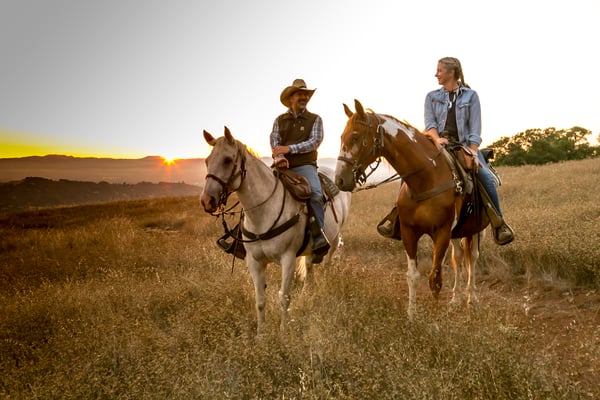
Trusted services
LandTrust helps make sharing easy, enjoyable, and safe. We verify personal profiles and listings, maintain a smart messaging system so Landowners and Recreators can communicate with certainty, and manage a trusted platform to collect and transfer payments.
